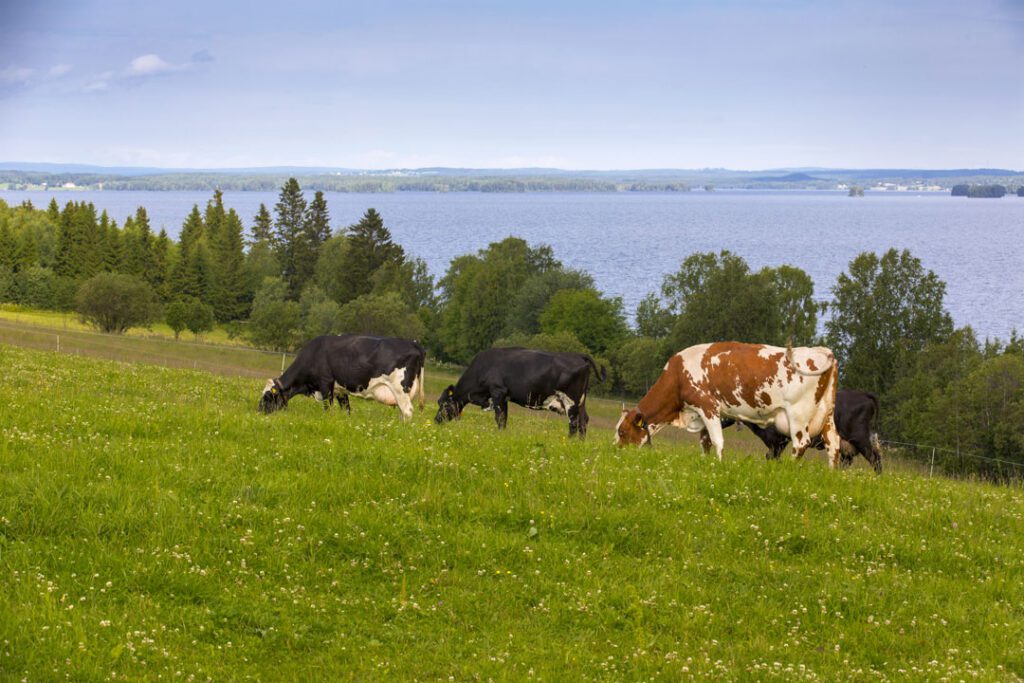Share this page


Alignment with SDGs
AUTHOR
Victoria Thuillier - LRF Dairy Sweden, Stockholm • Sweden, Anna-Karin Karlsson - Norrmejerier Dairy Coop, Umeå • Sweden
Abstract
Every dairy farmer in Northern Sweden and their agricultural activity is essential for maintaining biodiversity, protecting endangered species and delivering a resilient food system for future generations.
The big picture
The area of northern Sweden is one of the most northerly areas with agricultural production in the world. This offers unique conditions to produce food, ecosystem services and biodiversity. Increased knowledge in the role and potential of dairy farming in this region is key to deliver long term sustainable food production.
The biggest threat to biodiversity in the agricultural landscape in Sweden is overgrowth and lack of grazing livestock. Short summers with many daylight hours in the north creates unique conditions to grow grass, while many other feed crops are not suitable to the area. Grazing livestock are necessary to maintain species-rich permanent or semi-permanent grassland areas that are under constant risk of overgrowth and being left abandoned. This has serious consequences for many ecosystem services and our future ability to produce food and bioenergy in the area.
Furthermore, improved knowledge is also important for social sustainability and farmer pride and confidence in a time where dairy farming and its role is often questioned from an environmental perspective. At the same time the sector must attract more young people. Best practice examples of sustainable farming will also improve the understanding among decision makers and consumers.
The promise
The aim of this initiative by Norrmejerier Dairy Coop, was to study biodiversity on eight different dairy farms located in different regions in the area during the summer of 2020, to support and improve the knowledge of the role of dairy farming for biodiversity in northern Sweden today.
Moving the wheel
A field study was conducted over two consecutive days on each of the farms in July 2020. Each farmer was also interviewed about management practises etc during the visits. The study was financed by Norrmejerier and conducted on eight of their members, farms.
The farms were chosen to represent the different regions and main nature types in the Norrmejerier uptake area. The most northerly farm in the study is located near Övertorneå, less than 20 km south of the Arctic circle (66°23′17″N 23°39′13″E) and the most southerly farm is located in Nordingrå (62°55′45″N 18°17′14″E) in the High Coast área in central Sweden. By road an approximate distance of 600 km north/south. West to east, the distance between the farms in the study was approximately 500 km. The most western farm was located in the mountain area and the most eastern farms were located along the river valleys close to the Baltic coast.
Dairying has nature-positive benefits. Dairy farmers care for a significant portion of the world’s agricultural land and many dairy farmers have systems in place to support biodiversity and provide ecosystem services.
Victoria Thuillier Tweet
History of success
Over 200 different plant species were observed on the eight different farms, of which eight species are classified as endangered. Local conditions, proximity to water courses and amount of permanent grassland did have an effect on biodiversity. Management factors such as reseeding interval and timing of harvest were also important in ley and semi-permanent grasslands. Species diversity in semi-permanent grasslands was almost as rich as in permanent grasslands. The study confirms the importance of grazing livestock and grassland management in maintaining biodiversity. Several birds and other wildlife species that are rare in southern Sweden were found to be more abundant on the studied farms.
The value of the initiative
The study confirms the importance of dairy farming in all of Sweden for biodiversity, and in northern Sweden in particular. A more balanced approach to sustainability by showing good examples will also contribute both to attract more young people into dairying and improve the understading among decision makers and consumers.
New opportunities
Future opportunities include identifying indicators of high biodiversity and improved opportunities for farmer renumeration for biodiversity and ecosystem services, which also will contribute to economic and social sustainability, especially in rural areas.
The information is also valuable in developing strategies to maintain and enhance biodiversity and overall resilience in the food and energy system. Furthermore, it is valuable information when discussing future planning of land use in the local community.


More information
The results and the report is one of many key steps in increasing the understanding of the importance of dairy production for biodiversity and broader sustainability in northern Sweden. This also contributes to the Swedish dairy sector sustainability goals, signed in 2020, where enchancing biodiversity is one focus area.






